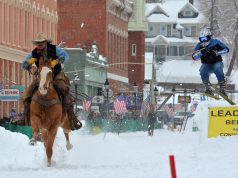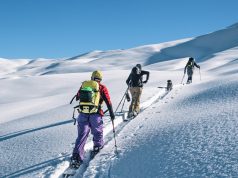
We are in a mixed pine and aspen forest at about 8,000 feet. We walk slowly, scanning the ground for signs of the golden fungus we intend to pile high in our wicker basket. We have seen everything we don’t want — russulas, puffballs and trash. When we do finally find a chanterelle trumpeting out of the ground, my mush room guide scoops it up, examines the underside ridges through a magnifying glass and drops it into the basket beside the other objects he’s collected: a dusty pink lighter, a beer can and broken amber glass.
“This is a wild lighter, a rare breed,” says Michael Heim, my guide who was once briefly a stand-up comedian and is now the owner of a mushroom operation on the site of the 63rd Street Farm. “And this is beercansius adendus, very rare… Sometimes you’re just a trash collector,” he continues. “But that’s OK.”
The chanterelle we harvest smells sweet like apricot, and though Heim says they are difficult to find in Colorado, this time last week he picked three to four pounds in this spot. He says multiple things could account for the lack of chanterelles today — dry heat, over-foraging, bad luck.
“You can get disheartened, not finding mushrooms,” he says. “But look around, we are so lucky that we live in this beautiful place and are able to come out here and do this. I mean we could be in Syria right now, or some war-torn place.”
I realize I haven’t looked up at the horizon once — which is expansive, green and fades into hazy hills and valleys miles away from us. My eyes have been stuck to the ground, scanning for the iconic orange of chanterelles while we have been marching. The hunt is on, and my focus is singular.
That’s why Heim is out here, for the hunt and for the singular focus. It’s what drives him. He calls it “compulsive,” and says, “I think there is a relationship between my tendency to be compulsive at a bar and my tendency to be compulsive when mushroom foraging, always thinking that I can go one step further, find one more mushroom. It’s such a thrill.”
It started when he was a kid. Over Christmas break he would go out with his Dad in the Nebraskan prairie and hunt coyotes. As an adult, the hunt manifests in different ways — mushroom foraging, thrift storing, for a while it was drinking, maybe all in an attempt to quell thinking too much about the world’s problems.
Heim studied political science in college and he says he thinks too much about the state of the world, the chaos, the madness. Today, unlike normal life, he has one thing on his mind: chanterelles.
We have been marching over miles and miles of mycelium, which most people don’t realize is the body, stomach, and nervous system of fungus. Mushrooms themselves are the fruit, like an apple, and mycelium is the “tree,” a fuzzy white web that runs underground that, in old growth forests, can be so dense that there are 300 miles of it in one footstep. It is a constant traveler, growing up to several inches per day.
Mycelia, Heim says, are “magical.” The web-like structures release acids and enzymes that break down rocks and decompose material, leaching minerals and nutrients that not only nourish mycelium’s own mushroom babies, but are made available to other plant species as well. Mycelia are the gatekeepers of life: Without them, ecosystems would fail.
So it’s important, Heim says, that when people forage the fruit of mycelium, they do it carefully so as not to damage the mother web beneath.
There’s a whole movement, a whole history in fact, of harvesting sustainably. These days it’s called “wildcrafting,” but it used to be the standard way of foraging and still is in indigenous societies, says ethnobotanist Erin Smith, Heim’s friend and former mentor. People who grew up harvesting wild edibles knew that if they wanted them to come back, they had to do it a certain way, says Smith.
Today, the ethical and sustainable harvesting of wild food is threatened by the commodification of wild edibles like mushrooms. Those who harvest mushrooms by raking the earth, for example (often searching for mush rooms that hide under the soil), degrade the mycelium, exposing it to dryness and light, which kills it. Those who are looking to harvest mushrooms for a profit might use rakes because it’s quicker and so their profits are bigger. That’s just bad karma, says Heim.
“Know what your intentions are,” he says. “I even say to myself sometimes, ‘Wait Michael, what are your intentions here? Do you really need to take that many? Do you really need to pick the little one?’”
Alongside the slow-food movement, wildcrafting is a growing trend, and Heim wants to empower people with the knowledge to go out in the woods and take only what is necessary. Much of what he learned about giving thanks and gratitude for a harvest, he learned from Smith as an intern at her school.
Smith is the founder of the Center for Integrated Botanical Studies, and has dedicated her life to studying how humans have evolved with plants. She has lived and studied with indigenous societies in Peru, Ethiopia and Morocco, among others, and she finds huge life lessons in wildcrafting.
“Wildcrafting is a sacred act,” she says. “It puts you in a different place, it brings into question that sense of entitlement that we have as a culture. Alongside that, there is something we innately crave in being in nature and being able to find our food and support ourselves on that. It is so much a part of who we are. It taps into something really primal that I think we miss and long for, so it’s empowering.”
Smith has three rules for wildcrafting, and Heim follows them. One, take only what you need. Two, get permission, whether that is in “an esoteric way” or means getting a permit requiring first that you understand what sustainable harvesting means. And three, give thanks and gratitude.
“Going out there and looking for [wild food] is part of the whole experience,” says Smith. “What an amazing gift to find it. Your gratitude builds as you do it, because it’s not a given that you will find anything. You can spend the whole day looking, and not find anything, that’s normal. It’s like going fishing. You hope you catch something, but it’s not a given. We’ve forgotten that nature is that way because we are so used to going into the store and finding whatever we want whenever we want it.”
When we find our first — and what will be our only — chanterelle for the day, Heim takes a moment to say thank you to the natural world. Then we continue our search with renewed vigor. I think I find a chanterelle and reach down to touch its surface, but it’s an eggshell.
“I’ve picked up dog shit before thinking it was a mushroom,” he says.
When we feel discouraged about not “scoring the motherload,” as Heim puts it, we talk about hunting for the hunt itself and tempering expectations from the get-go. Heim says he warns foraging clients from the outset that “Hey, we might find mushrooms, but 99 percent of what we find, I won’t be able to identify.”
He tells them, “Don’t expect too much, it’s nature,” and that, like in life, high expectations lead to disappointment.
If there is one thing I have learned today it is that mushroom foraging provides ample aphorisms, the cheesy kind that Heim and I agree are sentimental like the ones in self-help books. Yet we ultimately keep coming back to them as we walk.
We get lost, though not for long. Heim tells me that in these situations he practices a mantra, “Wait five minutes to panic.” He has gotten lost enough times that he carries a pack with a flashlight, a raincoat, some first aid and a compass “which I barely know how to use,” he says. In the end, it’s the “wait five minutes to panic” that always helps him the most. He thinks that practicing calmness in the woods can help with practicing calmness in everyday life.
“I have a lot of debt,” he says. He has anxiety about paying it off and is potentially moving into a remodeled bus on the farm to save money, pay off his debt and then open his mushroom business. What the business looks like is hard to say. There are many facets: taking clients mushroom foraging, teaching classes on medicinal mushrooms, making mushroom bitters and cultivating edibles and medicinals in the 400-square-foot mushroom garage on the 63rd Street Farm.
“I am at a disadvantage because I am not a businessperson,” he says. “And I have no money.”
Ultimately, Heim knows he wants to unlock the magic of foraging for people, and help them uncover the rare quiet and respite of the forest. He uses foraging like he uses meditation, as a practice for a quieter, more conscious existence.
“I grew up being afraid of mushrooms,” he says. “My mom would say, ‘Don’t touch that!’ But there is nothing more gourmet or choice than going out into nature and finding food for yourself. Organic is great, but what is even more exciting is going in and finding it as it was intended. You can go into nature and you don’t have to be afraid of it if you have the knowledge. Connection with your food sounds like the most basic thing ever, but we are disconnected. Our food comes in a bag, we take it out of the bag, and we’re always on the go. We don’t even sit down to eat. Foraging makes you slow down and provides you with singular focus. I don’t have to think about the world’s problems, or about ‘Gee, why did that person say that to me?’ It’s good for me to actively not think. So, I feel like everyone deserves to know this stuff.”
Respond: [email protected]














